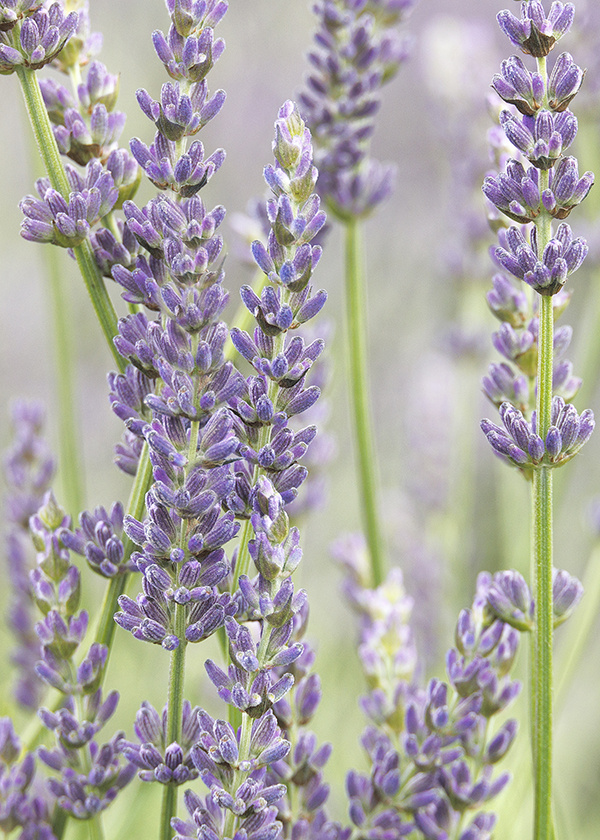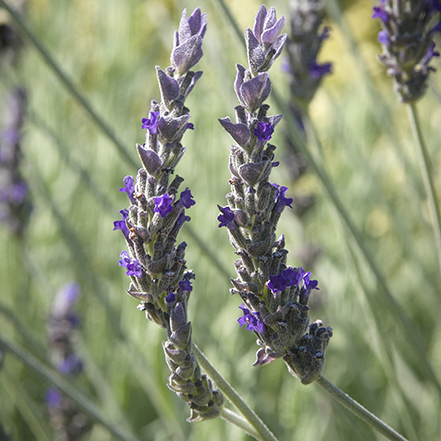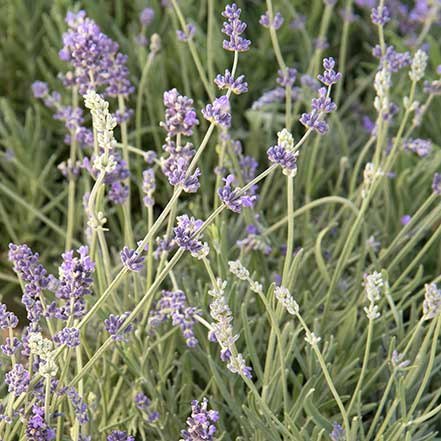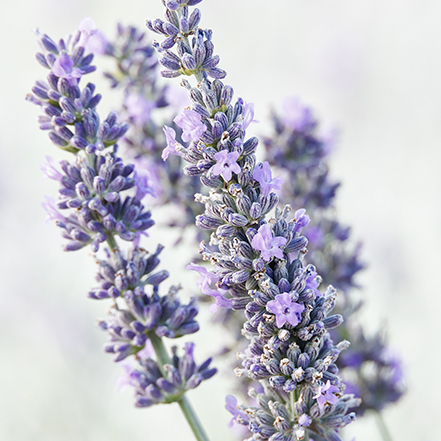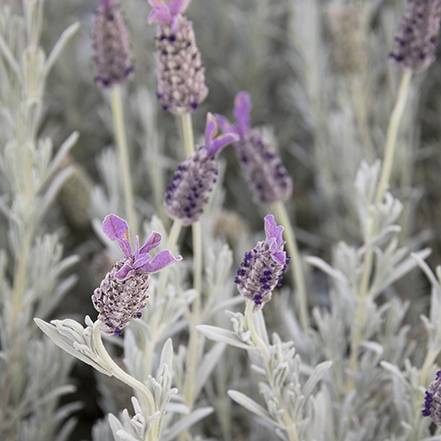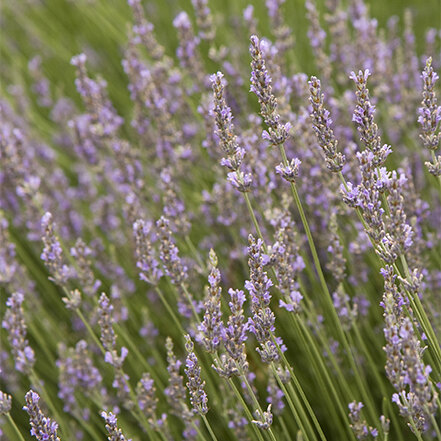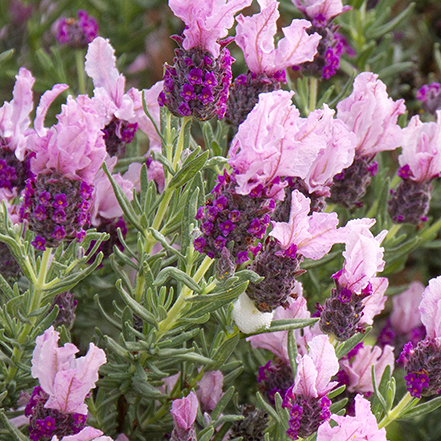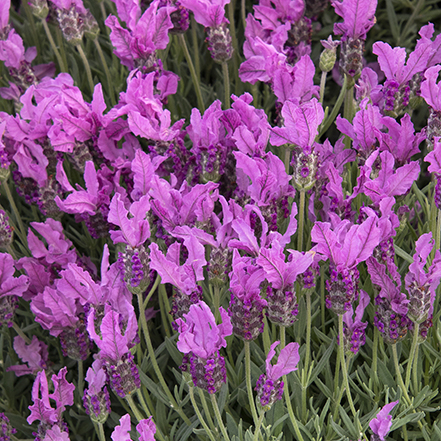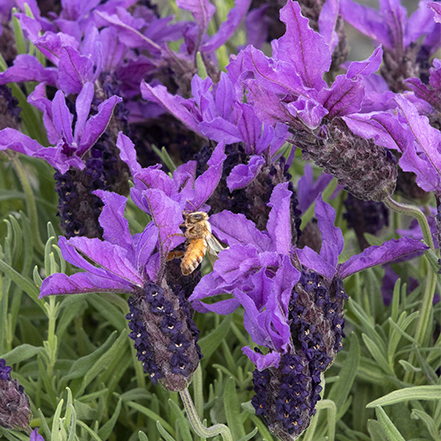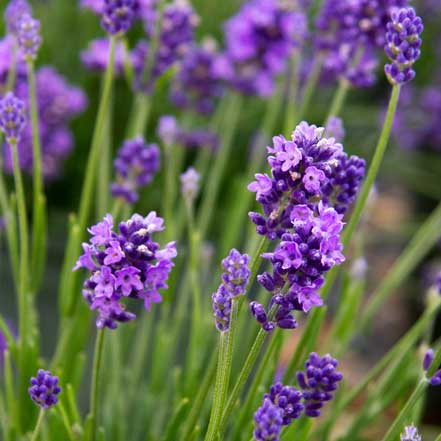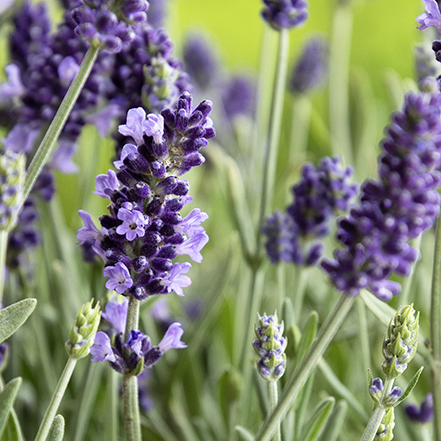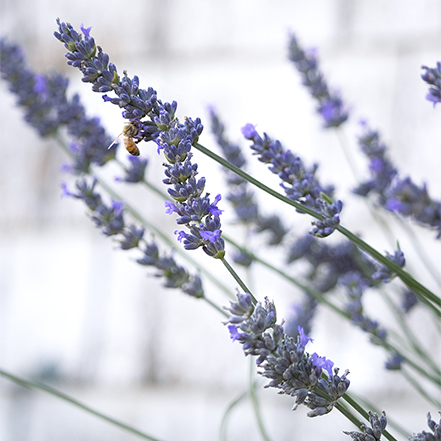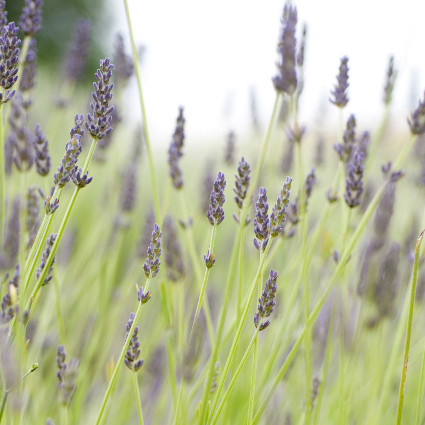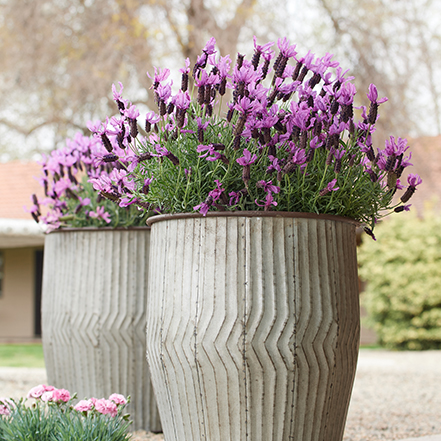Their native habitat is along the Mediterranean coast. Therefore, lavenders are happiest in places with moist, cool winters and hot, dry summers. And, full sun and well-drained soil. That’s pretty specific, right? If none of this sounds like your backyard, don't be deterred from trying lavender. As, except for the very cold zones, there's probably one that's right for you.
Types of Lavender Plants
While there are over 400 varieties of lavender, the most popular include:
- English (Lavandula angustifolia): The classic with long spikes holding fragrant flowers. Some varieties better tolerate heat and others might bloom longer in cooler climates. Most flower in late spring to early summer. Even after they’ve slowed in the flower department, what remains is a silvery mound of intensely fragrant leaves.
- French (Lavandula dentata): French lavender, known for its distinctively toothed leaves, is cherished for its long-lasting, subtly fragrant blooms. This variety is particularly resilient and can tolerate humid conditions better than others, making it a versatile choice for various garden settings.
- Spanish (Lavandula stoechas): Spanish lavender, easily recognized by its unique, pineapple-shaped blooms topped with vivid, purple bracts, is a standout in any garden. It prefers hot, sunny climates and is drought-resistant, making it ideal for low-maintenance landscapes. Its leaves are also edible and can be used (in moderation) for a pop of flavor in savory dishes or baked goods!
- Woolly (Lavandula lanata): Woolly lavender is notable for its silvery foliage that provides a striking contrast in the garden. It sprouts tall, deep purple flowers that contrast with its white leaves. Woolly lavender is native to hot and dry hillsides in southern Spain and needs well-drained soil with little to no overhead watering.
- English hybrids (Lavandula x intermedia): Known as the lavandins. The varieties in this group come latest in the bloom cycle. Starting just as the the English lavenders are finishing, and continuing to mid summer. Lavandins have long gray leaves, twice or more the size of L. angustifolias, and grow much larger and faster. Some are more adept at dealing with heat than their English parents.
So what grows well where? Here are our top picks for the best lavenders by region.
The Best Lavenders for Hot and Dry Climates
Southwest, West Coast, California
Yes, conditions in these areas are heaven for lavender in terms of growing well with little fuss. However, some, such as the hybrids, do perform better than others. If you have either very clay or sandy soil amend it well with organic matter such as compost.
Add gravel to the planting hole, and do not mulch around plants. This is true for all regions! Although lavenders are native to the Mediterranean, they need consistent moisture during the first few years. This helps to establish a strong root system. Once rooted in, only occasional water is needed.
Goodwin Creek
Gray Lavender
Heat tolerant and rugged with a compact, taller habit that makes for a charming short hedge. Up to 4′ tall and wide. Zones 7-9.
Munstead
Lavender
Compact habit with abundant, fragrant, flower spikes; perfect for hot, dry slopes. Up to 2′ tall and wide. Zones 5-9.
Riverina Thomas
Lavender
New triploid with large flowers that yield five times the aromatic oil of their parent types. Up to 3′ tall and wide. Zones 5-9.
Best Lavenders for Hot, Humid Climates
Mid-Atlantic, Upper and Lower South
In these humid places, try Spanish lavender or French lavender. Both seem to be more tolerant of steamy climates. As an extra precaution, make sure your plants are located where they will receive good air circulation. This will cut down on disease which can impact their overall health and flowering.
Silver Anouk
Spanish Lavender
Spring bloomer of tall winged flower spikes that stand up to summer heat and drought. Up to 2′ tall and wide. Zones 6-10.
Provence
Lavender
Gray-green foliage and abundant, fragrant, purple flower spikes that attract butterflies. Up to 2′ tall and wide. Zones 5-9.
Javelin Forte™ Deep
Rose Spanish Lavender
Pink flowers with very long ‘wings’. Superior heat tolerance and long bloom season. Up to 20" tall and 18" wide. Zones 6-10.
Best Lavender for Cool and Wet Climates
Coastal California, Pacific Northwest
Where the summer marine influence is strong, disease can affect some lavenders. Some (but not all) English and Spanish varieties do well here. As noted previously, proper soil prep will yield the best results. All of these varieties also do very well in containers.
The Princess™
Spanish Lavender
Intense pink, fragrant flowers on a robust selection. Perfect for containers or massed as a low hedge. Up to 15" tall and wide. Zones 7-9.
Javelin Forte™ Deep
Purple Spanish Lavender
Compact mound topped by a crown of purple flower spikes with deep purple bracts. Heat and drought tolerant. Up to 20" tall, 18" wide. Zones 7-9.
Thumbelina Leigh
English Lavender
Compact selection blooms up to three times a year when cut back by 1/2 after flowering. Up to 1′ tall and wide. Zones 5-9.
Best Lavenders for Cold Zones (Zone 5+)
Northeast, Upper Midwest, Interior West
These regions pose all sorts of challenges to growing lavender–cold winters, humid summers, often rich or heavy soils. But, yes, you can grow many varieties of this plant, particularly some of the English lavenders and the hybrids. First, select varieties that are cold tolerant. Some lavenders will survive temperatures as low as -10 degrees F. Then amend soil with sand and gravel, plant high (an inch or soil above soil line), and prune every spring.
Aromatico™ Blue
Imp. Lavender
Deep eggplant-purple fragrant flowers bloom earlier than most above silvery-green foliage. Up to 20′ tall. Zones 5-9.
Phenomenal
Lavender
Cold-hardy, does not die back in winter; notable for disease resistance and heat and humidity tolerance. Up to 3′ tall. Zones 5-8.
How to Grow Lavender in Containers
Sometimes dealing with soil, light, and weather complications are simply too complicated. Luckily you have a simple alternative–lavenders love to live in pots.
Make a lean soil mixture (1/3 sand, 1/3 topsoil and 1/3 compost is ideal). Add a handful of gravel or a pile of broken pottery shards to the bottom for additional assistance with drainage.
Place in full sun in a location with good air circulation. In colder zones, overwinter containers in a sheltered location. Top plants with a thick blanket of fallen leaves or mulch.
Caring for Your Chosen Lavender Type
Pruning and Maintenance Needs for Different Lavenders
Pruning and maintaining your lavender is essential for it to return year after year with healthy blooms. But how and when to prune lavender changes depending on the variety you have. Let's look at how to prune English and non-English lavender, and for more information, check out our guide on pruning lavender plants.
Pruning English Lavender
Prune your English lavender right after the first flowering and again in late August (after the last flush fades). To prune, cut off about 2/3 of the plant's height. Or cut to just above the bottom two sets of leaves on each stem.
Make sure you don't cut into the woody part of your plant. When you prune twice a year, you help keep your lavender healthy and compact.
Pruning Non-English Lavender
Non-English varieties, like French and Spanish, are the least hardy of all garden lavenders. That means you'll need to be gentle. Give your non-English lavender a trim after the first flush of flowers fades, and don't cut them back as much as with other varieties. Deadhead your lavender for the rest of the season. Come late summer, shape the foliage into a mounded form.
Ideal Soil and Watering Conditions for Lavenders
Lavender thrives in conditions that mimic its native Mediterranean environment. The perfect soil for lavender is well-drained, sandy, or gravelly with a neutral to slightly alkaline pH, as poor drainage and overly fertile soil can lead to root rot and diminish the plant's aromatic oils.
When it comes to watering, lavender's preference leans towards the drier side; overwatering can be more detrimental than under-watering. These plants are drought-resistant and only need water when the soil is nearly dry to the touch. During the growing season, deep, infrequent watering encourages the roots to grow deeper, making the plant more resilient during dry spells. In winter, reduce watering significantly as lavender plants enter a dormant state, and excess moisture can lead to root rot.
Additional Questions about Types of Lavender
What is the strongest-smelling lavender?
Hybrids are the most fragrant lavender plants. This lavender is less hardy than other varieties, but it grows larger and produces more flower spikes. English lavender is also cultivated for its strong scent.
How do I know if I have English or French lavender?
Both French and English lavender produce purple flowers and green foliage, but English lavender sprouts the traditional dark purple flowers with long stalks of tiny clusters, while French lavender produces lighter pink-purple blooms.
Where should I not plant lavender?
Lavender needs well-drained soil and plenty of sunlight. It will not survive in the shade; in wet areas, your lavender becomes susceptible to root rot. Make sure you research your specific lavender variety so you're aware of any special conditions it requires.
What happens if you don't prune lavender?
Regular pruning of lavender helps it grow back strong and healthy year after year. If you don't prune your lavender, over time, it'll become shapeless and woody and produce fewer flowers.
Need a primer on how to plant lavender? Here you go!
Learn More About Gardening with Lavender
Browse all Lavenders here. Explore all Monrovia plants here.
For more inspiration and information, please subscribe to our monthly newsletter.
Design School: Using Color in the Garden
